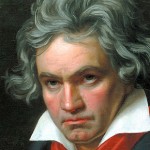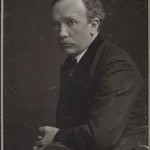WHY DOES BEETHOVEN SOUND DIFFERENT THAN RICHARD STRAUSS?
by Reed Hessler
Over the past few years, a WBJC listener has emailed me questions about classical music. Three years ago, he asked why there was a rivalry between fans of Brahms and Wagner. A year ago, he asked why Beethoven sounds different than Richard Strauss. Both times, I told him that I would have to give him a simple answer to a complicated question, but I also felt that our conversation could be shared in our WBJC newsletter. The Brahms versus Wagner discussion appeared a couple of years ago. Here is the Beethoven and RIchard Strauss discussion. The listener’s name will remain anonymous to respect his privacy.
Mr. Hessler,
Strauss’ Symphonic Poem is so different from Beethoven’s symphonies. To me (I have no education in classical music, as I’m sure you have gathered) Strauss work is without “order” and is therefore less enjoyable. What is that quality referred to in musical terms (lacking in order, the music seems “all over the place”).
Also is Strauss considered classical, romantic or another designation?
Greetings,
As before, I will have to give a very simple explanation for a very complicated question. First, Richard Strauss is considered to be a composer of the Romantic era. Since his music comes at the end of that era, and occasionally shows elements of the modernist era that followed, he is usually called a Late Romantic. Bear in mind that throughout music history, musical forms are constantly changing. This is the nature of art and life. Beethoven may seem like the standard for all time, but in reality he built his new style on the music of the Classical era, in particular the great composers Haydn and Mozart. By the time he died, Beethoven was writing music that was quite different from Haydn and Mozart, even though it incorporated elements from their music.
In turn, composers who followed Beethoven, like Schumann, Brahms, and Wagner, built their new styles on the music of Beethoven. They created something new which incorporated elements in Beethoven’s music that they found inspiring, but it did not directly copy Beethoven’s style.
 Beethoven started his career as a composer of the Classical era, but eventually wrote a newer style of music that is considered the beginning of the Romantic era. (Scholars argue whether Beethoven himself was a Romantic, or whether he was a composer of the Classical era who inspired the Romantics who came after him. Some, myself included, believe that Schubert was actually the first composer of the Romantic era. But enough of that convoluted argument for now.) Moreover, the term “classical music”, as you may know, is often used as a catch all phrase to describe all European art music from every era, but the Classical era itself is a specific time period from about 1750 to about 1810.
Beethoven started his career as a composer of the Classical era, but eventually wrote a newer style of music that is considered the beginning of the Romantic era. (Scholars argue whether Beethoven himself was a Romantic, or whether he was a composer of the Classical era who inspired the Romantics who came after him. Some, myself included, believe that Schubert was actually the first composer of the Romantic era. But enough of that convoluted argument for now.) Moreover, the term “classical music”, as you may know, is often used as a catch all phrase to describe all European art music from every era, but the Classical era itself is a specific time period from about 1750 to about 1810.
Composers in both the Classical era and the early Romantic era wrote in what has been called the Classical style. Symphonies, concertos, and chamber music (such as piano sonatas and string quartets) all used a structure known as sonata form. The first movement begins with an exposition, usually presenting two different musical themes. These themes are separated by transitional sections which allow the themes to move back and forth between different keys that have specified relationships to each other. For example, the first theme in C major would be followed by a second theme in G major. This is called the “tonic” key moving to the “dominant” key. (Of course, there are many variations on this rule, but it does help to give the music that “organized” quality that you mention.) The opening exposition is followed by a development section, in which the themes of the exposition are developed through variations. Here is where the creative composers create contrast and drama. Many of the variations are highly unexpected, and the movement from one key to another often goes far afield from the “tonic” and “dominant”, creating a wide variety of harmonic possibilities. Beethoven could take a piece in C major, and by the middle of the development, we might be in the key of F-sharp minor, which is as far afield from C major as it is possible to get. And of course Beethoven always chooses the right chords to get us to that place, so we feel the inevitability of being there, in spite of the strangeness. The development section is followed by the recapitulation, in which the exposition which opened the movement is repeated, but with enough changes to make it a development section of its own. As if we were returning home after a long absence to find that our house had a new coat of paint and a brand new wing added.
There are other structures in the Classical style, like rondo, and theme and variations. But these are what give Beethoven symphonies the feeling of organization that you have mentioned. They are full of excitement and drama, but within rigorous formal constraints, that a genius like Beethoven could transform into vehicles for his own originality.
Schubert, Mendelssohn, Schumann, and Brahms all used sonata form, but they added the pervasive use of lyric, spun out, heartfelt melodies that typified the Romantic era. By the time we get to Gustav Mahler’s symphonies in the early twentieth century, Mahler is STILL using sonata form, but he draws it out so much that one movement can be as long as half an hour! The themes and their contrasting sections themselves become stretched as far as possible. To this day, there are composers who write in sonata form.
However, in the middle of the 19th century, Franz Liszt explored a new musical form in his symphonic poems and piano works. Although Liszt did not do away with musical structure completely, he introduced a style called “thematic evolution”, in which a musical theme changes again, and again, and again. Liszt was the first composer to do away with sonata form. He did this to create what one might call a more poetic form of music; one with greater freedom of expression; almost as if the development section of sonata form was the entire composition. And in so doing he opened the door for musical works that would tell stories, or express philosophical ideas. This was not completely unheard of, even in the Baroque era, but never before had musical structure itself been dictated by the structure of a narrative or train of thought.
 By the time we get to Richard Strauss in the 1890’s, Strauss had an incredible arsenal of new musical influences at his disposal: the thematic evolution and narrative symphonic poems of Liszt, the harmonic experiments of Wagner, and the largest orchestras that had ever existed, with a huge variety of instruments. Strauss, like Liszt, does not do away with thematic development, but in “Till Eulenspiegel”, he is telling a story through music. There is a musical theme to represent Till. Not surprisingly, it appears frequently throughout the symphonic poem. There are also themes to represent various events in Till’s life. Some appear just once. Others go through transformations as the story progresses. When the story ends, the music is brought to its conclusion. As with Liszt, this was a new “freedom of expression” in music”; an exploration of new artistic possibilities in musical composition. Audiences loved it, and Strauss became the most acclaimed German composer of the 1890’s. Self expression was one of the hallmarks of the Romantic era, and to this day we have not recovered from it. The genie could not be put back in the bottle, and Pandora’s box would never be closed.
By the time we get to Richard Strauss in the 1890’s, Strauss had an incredible arsenal of new musical influences at his disposal: the thematic evolution and narrative symphonic poems of Liszt, the harmonic experiments of Wagner, and the largest orchestras that had ever existed, with a huge variety of instruments. Strauss, like Liszt, does not do away with thematic development, but in “Till Eulenspiegel”, he is telling a story through music. There is a musical theme to represent Till. Not surprisingly, it appears frequently throughout the symphonic poem. There are also themes to represent various events in Till’s life. Some appear just once. Others go through transformations as the story progresses. When the story ends, the music is brought to its conclusion. As with Liszt, this was a new “freedom of expression” in music”; an exploration of new artistic possibilities in musical composition. Audiences loved it, and Strauss became the most acclaimed German composer of the 1890’s. Self expression was one of the hallmarks of the Romantic era, and to this day we have not recovered from it. The genie could not be put back in the bottle, and Pandora’s box would never be closed.
Nonetheless, in the early twentieth century, some composers like Igor Stravinsky reacted against what they considered the excesses of the Romantic era, or perhaps they simply wanted to explore yet another new style. Stravinsky created what has been called the Neo-Classical style, in which modern harmonies, rhythms, and even structures were combined with the forms of the Baroque and Classical eras. Orchestras even became smaller in many of Stravinsky’s Neo-Classical works. A new historic perspective emerged that had been absent from much music before, in which composers looked to music of earlier centuries for inspiration, and considered themselves not only composers of their own day and age, but also part of a vast historic continuum which it was their duty to honor. And likewise the rest of us, whether musicians, audiences, or radio announcers, honor music’s continuum to this day, as we reap its treasures.
Best wishes,
Reed Hessler






